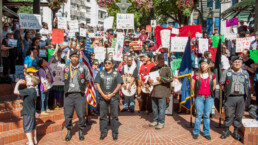While the divisions in our country are real and seem to widen every day, the threats we have in common are greater than what divides us.
By Pamela Haines, Waging Nonviolence
The new multi-billion-dollar Midwest Carbon Express pipeline — proposed last fall to carry ethanol refinery waste from Iowa to underground injection sites in North Dakota — has generated a wave of resistance over the threat of eminent domain, or the seizure of land for “public good.” The unlikely alliance of farmers, ranchers, Indigenous tribes, scientists and environmentalists that has arisen has hung banners off of freeway overpasses, rallied in front of the Iowa State Capitol and held meetings in communities all along the proposed route.

This campaign offers yet another example of the potential of working across lines of deep-seated traditional enmity to accomplish shared goals. They hearken back to the Cowboy and Indian alliance campaign against the Keystone XL pipeline in 2013. Native people and ranchers from the deeply red states of Nebraska and South Dakota riding their horses together into Washington, D.C. in full regalia, to set up camp near the White House and send a message as one to President Obama was a striking image of unity. They had come together, somewhat uneasily, to act in the face of a common external threat, but through that process they began to appreciate each other in different ways.
As this group of ranchers, farmers and tribal communities from along the tar sands pipeline route worked together against its construction, the tribes influenced some white neighbors to protect sacred burial sites on property they now owned. “We come from two cultures that clashed over land,” Alliance spokeswoman Faith Spotted Eagle observed. “This is a healing for the generations.”
Recent Posts
‘Unconstitutional. Unethical. Authoritarian.’ ICE Bars Millions Of Immigrants From Bond Hearings
July 18, 2025
Take Action Now One watchdog said the new policy “seems like a blatant attempt to stop them from exercising their right to due process.”……
Americans Are Not Nearly Alarmed Enough About Climate Change
July 18, 2025
Take Action Now Americans still don’t comprehend how imminent, dangerous, and far-reaching the threat is—and journalists are partly to blame.By…
The IRS Is Building A Vast System To Share Millions Of Taxpayers’ Data With ICE
July 17, 2025
Take Action Now ProPublica has obtained the blueprint for the Trump administration’s unprecedented plan to turn over IRS records to Homeland Security…
Israel’s Sudden Assault On Syria Is Unchecked Aggression
July 17, 2025
Take Action Now Jerusalem is bombing Damascus and threatening al-Sharaa’s rule, while Washington was hoping to help the nascent government on…




